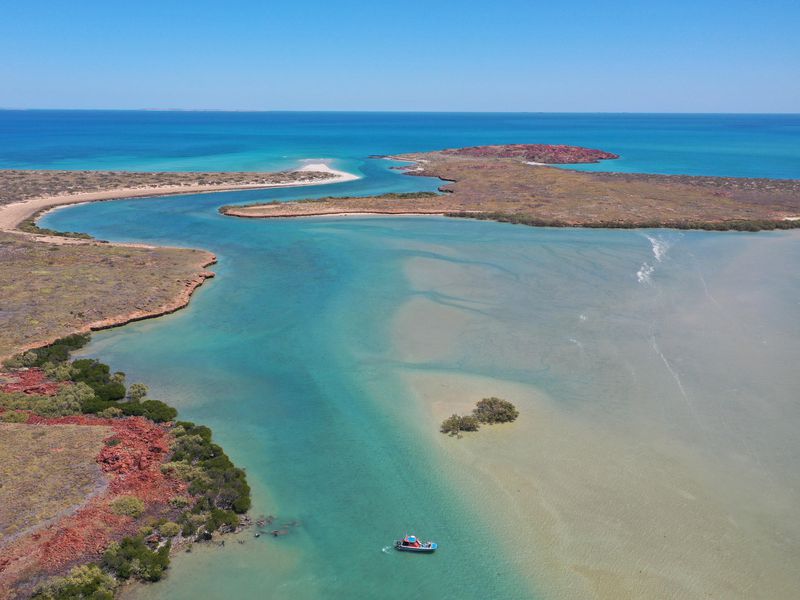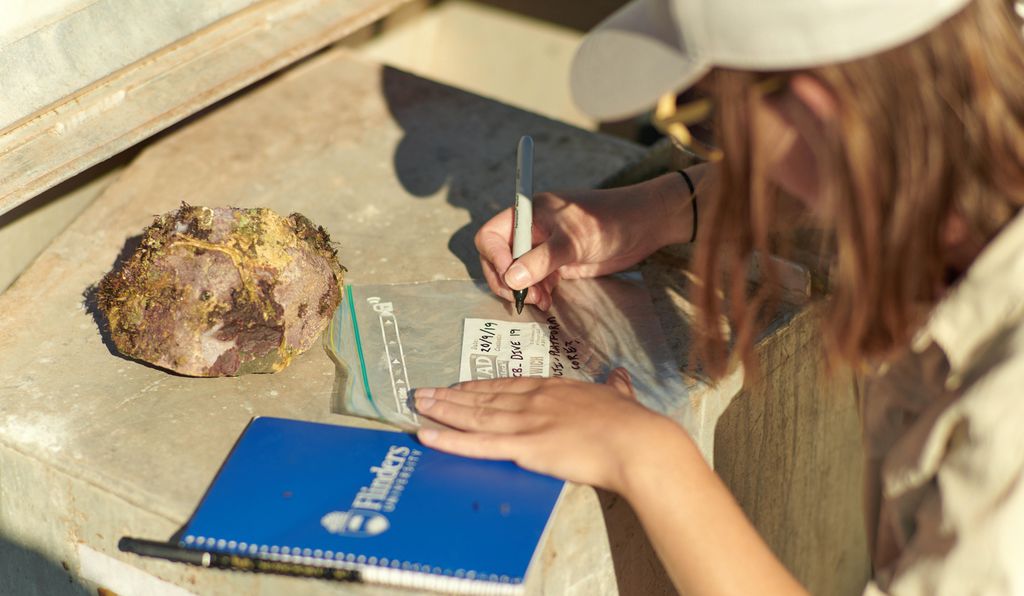DepthReading
A Submerged 7,000-Year-Old Discovery Shows the Great Potential of Underwater Archaeology
Stone tools scattered on the seafloor mark the oldest underwater site ever found on the continent.
Turquoise waters of the Murujuga site. (Flinders University)
Australia has a deep human history stretching back 65,000 years, but many of its oldest archaeological sites are now underwater. In an encouraging sign that Aboriginal artifacts and landscapes may actually be preserved offshore, archaeologists have discovered a 7,000-year-old site submerged along Australia's continental shelf, the first of its kind. Their discovery is outlined today in the journal PLoS One.
At the end of the last ice age, about 12,000 years ago, when glaciers melted and sea level rose, waters inundated one-third of Australia’s habitable land. As part of a project called Deep History of Sea Country, Jonathan Benjamin, a professor of maritime archaeology at Flinders University in Adelaide, led a team that searched for submerged sites off Murujuga (also known as the Dampier Archipelago), a dry and rocky coastal region in northwestern Australia.
This area has a wealth of inland archaeological sites, including more than one million examples of rock art. About 18,000 years ago, the shoreline of Murujuga would have extended another 100 miles further than the current coast. But Benjamin and his colleagues had little to go on when they began to search the offshore territory.
"We were going into an area completely cold in terms of the probability of discovery," Benjamin says. "So we just figured if we could throw every bit of technology and a lot of smart people at the problem, after three years, we should come up with something."
At first, the team used LiDAR-mounted airplanes and sonar-equipped boats to scan the shallow seas around Murujuga for places that might have the right conditions for preservation of artifacts. (They ruled out areas where the seabed is covered in lots of shifting sand, for example.) Last year, divers suited up in scuba gear to survey the identified targets. The first few sites delivered no finds. Then came Cape Bruguieres Channel.
Chelsea Wiseman, a doctoral student at Flinders University, recalls swimming through turquoise water when her colleague, John McCarthy, grabbed her fin and showed her an igneous rock stone tool. "The first one he handed me was just unmistakably a lithic artifact," Wiseman says. "Then we found four or five others."
The team ultimately found 269 stone artifacts at Cape Bruguieres Channel, buried under about eight feet of water. The various tools appeared to be designed for activities like scraping, cutting and hammering, and the researchers found one grindstone that may have been used for crushing up the seeds of Spinifex grass for baking into bread. Based on radiocarbon dating and an analysis of when this spot became submerged, the researchers think the artifacts are at least 7,000 years old. The team also describes a second site, Flying Foam Passage, a freshwater spring about 45 feet below sea level and at least where one stone tool that's at least 8,500 years old turned up.
"A lot of our understanding of Australian Indigenous archaeology is based on sites that would have been significantly further inland,” Wiseman says. “This discovery will help indicate that there is more to be found offshore."
Location of the Murujuga site (Benjamin et. al.)
Marine geo-archaeologist Nicholas Flemming of the U.K.'s National Oceanography Centre, who was not involved in this study, says archaeologists are particularly interested in studying the northern and northwest coast of Australia. Sites like Cape Bruguieres Channel may contain evidence that tells scientists more about how people first crossed the sea from Southeast Asia to arrive in the continent and how they lived in this now-sunken coastal environment. "The discoveries by Benjamin’s team provide the first clues to answering both these questions, and show that the material does survive on the seafloor, and can be discovered and analyzed as accurately as archaeology on land," Flemming says.
Flemming adds that this study marks the first time any marine sites older than 5,000 years have been found in the tropics. Most submerged prehistoric sites are discovered by random chance, he says—by trawlers, dredgers or divers who then report the sites to conservation authorities. "The discovery proves that stone tools do survive on the sea floor in tropical environments,” Flemming says, though these undersea sites are vulnerable to coral growth, algae, mangroves, cyclones and other threats.
"It is a really exciting find, and it just continues to push the idea of submerged continental shelf sites to the forefront," says Amanda Evans, a marine archaeologist with Gray & Pape heritage consultants in the U.S. who also wasn't involved in the study. "Even up until ten years ago, there were just a handful of people who were really actively engaged in this work. These types of discoveries get more people involved and talking."
Indeed, while marine archaeology has long been focused on shipwrecks, the last decade has seen a rising interest in more ancient sunken landscapes with subtler features. The amount of submerged continental shelf around the world constitutes an area the size of Africa, meaning a lot remains to be explored.
Benjamin and his colleagues documented the world's oldest seawall at a 7,000-year-old site off the coast of Israel. Other teams are exploring the west coast of North America searching for sites that may settle long-standing debates about how humans first populated the continent. Evans just got back last week from a six-day expedition in the Gulf of Mexico, where 40 million acres of land that was dry 12,000 years ago is now underwater. She and her colleagues took 40 core samples from the underwater sediment that they plan to analyze for archaeological material.
But if the world’s submerged sites are to be explored, first they must be protected.
Benjamin hopes the finds from Murujuga will impact public policy regarding maritime heritage in places like Australia that have a lot of offshore energy development but haven't given much protection for underwater landscapes with Indigenous archaeology—in part because they haven't been documented yet.
"We have a situation in Australia where a shipwreck that's 75 years old is given automatic protection, but to protect a site of 7,000 years old, we have to ask for ministerial approval," Benjamin says.
Category: English
DepthReading
Key words:



